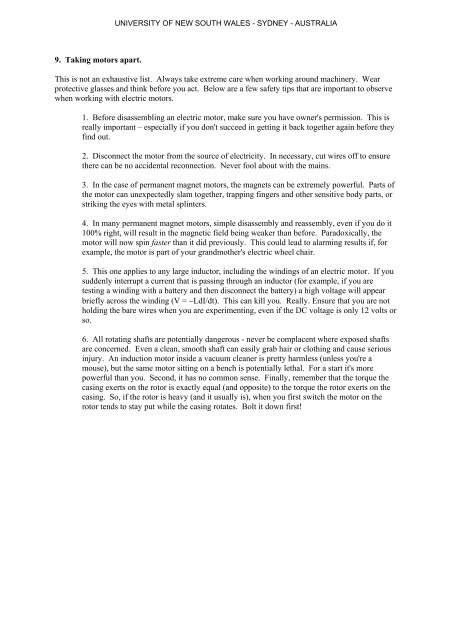How real electric motors work - School of Physics - The University of ...
How real electric motors work - School of Physics - The University of ...
How real electric motors work - School of Physics - The University of ...
You also want an ePaper? Increase the reach of your titles
YUMPU automatically turns print PDFs into web optimized ePapers that Google loves.
UNIVERSITY OF NEW SOUTH WALES - SYDNEY - AUSTRALIA<br />
9. Taking <strong>motors</strong> apart.<br />
This is not an exhaustive list. Always take extreme care when <strong>work</strong>ing around machinery. Wear<br />
protective glasses and think before you act. Below are a few safety tips that are important to observe<br />
when <strong>work</strong>ing with <strong>electric</strong> <strong>motors</strong>.<br />
1. Before disassembling an <strong>electric</strong> motor, make sure you have owner's permission. This is<br />
<strong>real</strong>ly important – especially if you don't succeed in getting it back together again before they<br />
find out.<br />
2. Disconnect the motor from the source <strong>of</strong> <strong>electric</strong>ity. In necessary, cut wires <strong>of</strong>f to ensure<br />
there can be no accidental reconnection. Never fool about with the mains.<br />
3. In the case <strong>of</strong> permanent magnet <strong>motors</strong>, the magnets can be extremely powerful. Parts <strong>of</strong><br />
the motor can unexpectedly slam together, trapping fingers and other sensitive body parts, or<br />
striking the eyes with metal splinters.<br />
4. In many permanent magnet <strong>motors</strong>, simple disassembly and reassembly, even if you do it<br />
100% right, will result in the magnetic field being weaker than before. Paradoxically, the<br />
motor will now spin faster than it did previously. This could lead to alarming results if, for<br />
example, the motor is part <strong>of</strong> your grandmother's <strong>electric</strong> wheel chair.<br />
5. This one applies to any large inductor, including the windings <strong>of</strong> an <strong>electric</strong> motor. If you<br />
suddenly interrupt a current that is passing through an inductor (for example, if you are<br />
testing a winding with a battery and then disconnect the battery) a high voltage will appear<br />
briefly across the winding (V = −LdI/dt). This can kill you. Really. Ensure that you are not<br />
holding the bare wires when you are experimenting, even if the DC voltage is only 12 volts or<br />
so.<br />
6. All rotating shafts are potentially dangerous - never be complacent where exposed shafts<br />
are concerned. Even a clean, smooth shaft can easily grab hair or clothing and cause serious<br />
injury. An induction motor inside a vacuum cleaner is pretty harmless (unless you're a<br />
mouse), but the same motor sitting on a bench is potentially lethal. For a start it's more<br />
powerful than you. Second, it has no common sense. Finally, remember that the torque the<br />
casing exerts on the rotor is exactly equal (and opposite) to the torque the rotor exerts on the<br />
casing. So, if the rotor is heavy (and it usually is), when you first switch the motor on the<br />
rotor tends to stay put while the casing rotates. Bolt it down first!
















